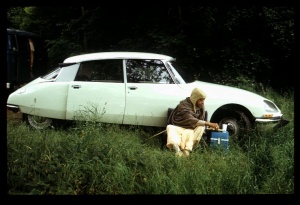SB 3.31.45-46

A.C. Bhaktivedanta Swami Prabhupada
TEXTS 45-46
- dravyopalabdhi-sthānasya
- dravyekṣāyogyatā yadā
- tat pañcatvam ahaṁ-mānād
- utpattir dravya-darśanam
- yathākṣṇor dravyāvayava-
- darśanāyogyatā yadā
- tadaiva cakṣuṣo draṣṭur
- draṣṭṛtvāyogyatānayoḥ
SYNONYMS
dravya — of objects; upalabdhi — of perception; sthānasya — of the place; dravya — of objects; īkṣā — of perception; ayogyatā — incapability; yadā — when; tat — that; pañcatvam — death; aham-mānāt — from the misconception of "I"; utpattiḥ — birth; dravya — the physical body; darśanam — viewing; yathā — just as; akṣṇoḥ — of the eyes; dravya — of objects; avayava — parts; darśana — of seeing; ayogyatā — incapability; yadā — when; tadā — then; eva — indeed; cakṣuṣaḥ — of the sense of sight; draṣṭuḥ — of the seer; draṣṭṛtva — of the faculty of seeing; ayogyatā — incapability; anayoḥ — of both of these.
TRANSLATION
When the eyes lose their power to see color or form due to morbid affliction of the optic nerve, the sense of sight becomes deadened. The living entity, who is the seer of both the eyes and the sight, loses his power of vision. In the same way, when the physical body, the place where perception of objects occurs, is rendered incapable of perceiving, that is known as death. When one begins to view the physical body as one's very self, that is called birth.
PURPORT
When one says, "I see," this means that he sees with his eyes or with his spectacles; he sees with the instrument of sight. If the instrument of sight is broken or becomes diseased or incapable of acting, then he, as the seer, also ceases to act. Similarly, in this material body, at the present moment the living soul is acting, and when the material body, due to its incapability to function, ceases, he also ceases to perform his reactionary activities. When one's instrument of action is broken and cannot function, that is called death. Again, when one gets a new instrument for action, that is called birth. This process of birth and death is going on at every moment, by constant bodily change. The final change is called death, and acceptance of a new body is called birth. That is the solution to the question of birth and death. Actually, the living entity has neither birth nor death, but is eternal. As confirmed in Bhagavad-gītā, na hanyate hanyamāne śarīre: (BG 2.20) the living entity never dies, even after the death or annihilation of this material body.